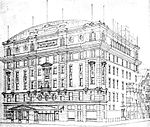Adam Clayton Powell Jr. State Office Building
1970s architecture in the United States1974 establishments in New York CityBrutalist architecture in New York CityGovernment buildings completed in 1974Government buildings in Manhattan ... and 4 more
HarlemSeventh Avenue (Manhattan)Skyscraper office buildings in ManhattanUse mdy dates from August 2019

The Adam Clayton Powell Jr. State Office Building, originally the Harlem State Office Building, is a nineteen-story, high-rise office building located at 163 West 125th Street at the corner of Adam Clayton Powell Jr. Boulevard in the Harlem neighborhood of Manhattan, New York City. It is named after Adam Clayton Powell Jr, the first African-American elected to Congress from New York. It was designed by the African-American architecture firm of Ifill Johnson Hanchard in the shape of an African mask in the Brutalist style. It is the tallest building in Harlem, overtaking the nearby Hotel Theresa.
Excerpt from the Wikipedia article Adam Clayton Powell Jr. State Office Building (License: CC BY-SA 3.0, Authors, Images).Adam Clayton Powell Jr. State Office Building
West 126th Street, New York Manhattan
Geographical coordinates (GPS) Address External links Nearby Places Show on map
Geographical coordinates (GPS)
| Latitude | Longitude |
|---|---|
| N 40.80923 ° | E -73.94746 ° |
Address
Adam Clayton Powell Jr. State Office Building
West 126th Street 163
10027 New York, Manhattan
New York, United States
Open on Google Maps








